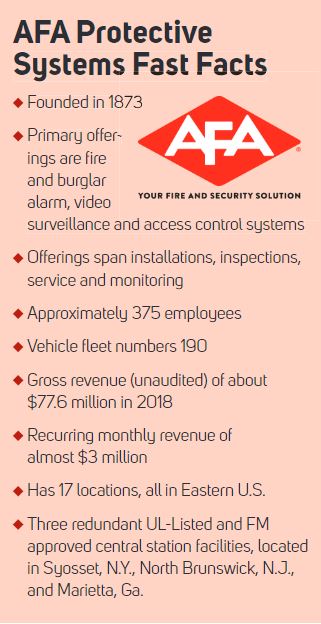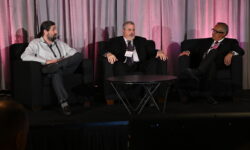AFA Execs Discuss Key to Longevity, Trends in the Industry
AFA has been streamlining operations, overcoming challenges, tackling trends, opening up markets and outfoxing competitors for over a century. Here’s how.

Building and growing a loyal customer base is key to longevity — an outcome correlated to expertise, execution and excellence. Find out how one of the industry’s mightiest oak trees continues to seed opportunities and branch out in new directions.
When a company is one of the longest established in its industry and has revenues among the highest in that field there is the distinct possibility that the dreaded ‘c’ word — complacency — could rear its destructive head.
While being the fat cat is certainly better than struggling like a hungry dog, for a business to avoid stagnation and lost market share it’s essential to maintain the eye of the tiger. That is not lost in the least by AFA Protective Systems, which more than a century after its founding continues to partner with its clients, refine operations, pursue new opportunities and grow.
Beginning life as Automatic Signal Telegraph Co. of NYC in 1873 and beginning to transmit fire alarm signals two years later, the firm became Automatic Fire Alarm in 1948 and in 1970 changed to its current moniker. That was just after Philip Kleinman took control of the business, following the Grinnell divesture that broke up ADT, Holmes and AFA.
His sons, Robert and Richard Kleinman, began working at the company shortly thereafter and are now, respectively, CEO and COO. The third generation, David and Jared Kleinman, are also executives in the business.
Through the years as AFA Protective adopted new technologies and offered expanded services (including what it says is the nation’s longest-running central station), it continued to grow both its revenues and geographic footprint.
Today, the full-service fire and security systems provider runs 17 locations spanning the entire Eastern U.S., with three monitoring facilities and 375 employees generating nearly $80 million in annual revenues.
A top recent initiative has been to increase recurring monthly revenue and to that end nearly half of AFA’s income is now derived from RMR. This includes the February announcement of a new two-year, $8.2 million fire alarm inspection contract at JFK Airport from the Port Authority of New York and New Jersey.
The deal was the firm’s largest ever of its kind and has enabled the Syosset, N.Y.-headquartered AFA Protective Systems to achieve a 20% bump in its RMR base the past three years.

To find out more about that growth and how AFA is streamlining operations, overcoming challenges, tackling trends, opening up markets and outfoxing competitors, SSI spoke with a half-dozen of the fire and security contractor’s leadership team.
Sharing that insider perspective just ahead are COO Richard Kleinman, Executive Vice President David Kleinman, Vice President & CIO Mark LaBua, Vice President of Branch Operations Mike Slattery, Vice President of National Accounts Stephen Hyle and Vice President of Marketing Jared Kleinman.
The business has come a long way in its nearly 150-year history. What are the most significant recent developments?
RICHARD KLEINMAN: The biggest thing is a strategic shift to focus on recurring revenue. That’s been the theme of everything we’ve done. In addition, we started really trying to market the company better. It’s been a very interesting process re-doing the website and rebranding. Jared was the one who led this initiative. Marketing to commercial property managers is not the same thing as sending out a flyer to a residential customer. For the most part we’ve been successful with it, but we’re fine tuning how to go to market.
JARED KLEINMAN: We have placed an emphasis on targeted and trackable channels of marketing that generate a reasonable return on our investment, and we have ramped that up over the past five to six years. That correlates to our focus on specifically marketing to build our recurring revenue base. Another big trend for us the past few years has been focusing on building technology internally and customer facing so we can deliver our services more efficiently. We understand people want the ability to make changes to their alarm system, receive information immediately and have the ability to access their account information securely. We have paths that allow our customers to access their central station account information and see what’s going on. Instead of calling in, they can manage their account remotely, and we’ve been making a push on that.
R. KLEINMAN: We’ve developed a couple of apps for internal use. We have a service tech app. Other people have this. It’s not rocket science, but it cuts down tremendously on our in-house paperwork. When service techs are onsite, we know where they are. We know how long they’re there. We know what materials they used on a job, and it helps our service billings go out quicker. We also have a project manager app. When they’re out on a job, they can just enter information, and it gets updated so we can all see what’s going on.
MARK LABUA: In addition to those apps, we’ve created and implemented a new sales estimating tool. We hope it will have a major effect on the company and allow the salespeople to be more efficient and quote jobs quicker, providing more detail and allowing them to get to the next opportunity that much faster.
R. KLEINMAN: We’re also developing a single integrated customer app for a multitude of control and functions. This way customers don’t have to download and use three or four different ones.
What is your 2019 revenue projection and what would help meet or exceed that?
MIKE SLATTERY: On a company-wide level and by branch, we’ve been bolstering the salesforce the past few years. Our anticipation for 2019 is that we should really begin to start taking advantage of the time, energy and effort we’ve put into hiring, training and preparing the salesforces in all our branches to go to market and have one of our most successful years ever. Our projections for business in our branches are all higher than they were in previous years, and we expect the company to do very well in 2019.
STEVE HYLE: With respect to national accounts, we can continue to anticipate steady growth. One of the strongest areas of growth we’ve experienced the past decade and will continue to anticipate experiencing is life-safety inspections, specifically fire alarm inspections for our clients. It’s something we continue to see a lot of interest in on the part of our national accounts for those services.
DAVID KLEINMAN: The economy seems to be pretty good right now and people are spending money. I can say that since I’ve been approving jobs, which began midway through 2015, this year was the strongest January I’ve ever seen — and that is excluding the JFK contract. I don’t know if it’s just from the economy. I don’t know if our salesforce is just better equipped, if they’re more comfortable, if it’s we’re going into newer markets, because for the most part it still seems to me the large jobs coming in are commercial fire alarm jobs, but the opportunities are there.
One of the larger jobs we had was a fire alarm installation for a V.A. hospital, and now we’re able to pick up the recurring revenue on that hospital. We are GSA listed, which enables us to get into government opportunities. In Atlantic City, we were able to get a fire alarm retrofit in a casino. There’s also a fire alarm system, a conversion from a competitor over to AFA for a hospital. We’re doing well and, as Jared had mentioned, with marketing efforts and having redesigned our commission plans geared towards recurring revenue, 2019 looks to be very good indeed.
What are the top operational challenges you’re looking at today, and how are you dealing with those?
HYLE: From a national account perspective, across our account base we’re seeing the emergence of clients utilizing web portals associated with facilities service or automation systems. When working with these clients, you have to be familiar with the processes by which their portals operate. This includes different levels of reporting as well as processes for dispatching service, and reporting from a field level back to that portal. There’s a lot of complexity, and as a result the complexity of our business has increased exponentially in recent years.
SLATTERY: From a branch perspective, the greatest challenge is maintaining trained and licensed staffed professionals to do our field service and inspection work. We need to keep our customer service levels at the appropriate point where our customers have grown used to us being a great service organization and highly responsive. There seems to be fewer people coming into our industry, so we are challenged with identifying young people, training them quickly, getting them licensed and making them effective as fast as we can. The same goes for taking in people from other companies and teaching them the way AFA does things.
D. KLEINMAN: Another challenge we deal with are the legal terms as everybody we’re trying to do business with has a contract. We have a contract, whether it’s for the sale of equipment or for the sale as well as installation of the system, and we also have a service contract. Everybody on the other end also has a contract. Say I’m a property manager, you’re coming into my building and I have a contract. Or I’m a retail provider, and I have this contract. Or I’m a school board, and I have that contract. Legally working through all of the contractual hang-ups can be very taxing for all involved.
Keep reading to see what AFA has to say about its competition…
If you enjoyed this article and want to receive more valuable industry content like this, click here to sign up for our FREE digital newsletters!

Security Is Our Business, Too
For professionals who recommend, buy and install all types of electronic security equipment, a free subscription to Commercial Integrator + Security Sales & Integration is like having a consultant on call. You’ll find an ideal balance of technology and business coverage, with installation tips and techniques for products and updates on how to add to your bottom line.
A FREE subscription to the top resource for security and integration industry will prove to be invaluable.










